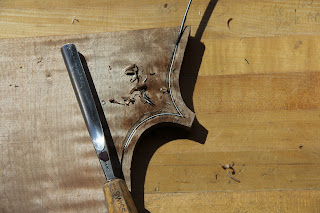Carl F. Becker 1920 - 2013
On the morning of January 30, 2013, Carl F. Becker went to his eternal reward. Carl Becker was my teacher, inspiration, colleague, friend; the earth seemed to shudder as when giants of the forest tumble home.
Numerous tributes have recounted his achievements as a violin maker, restorer, and expert. To those lucky enough to have studied with him, he will always be remembered as the most inspiring man we ever knew. During much of the 20th Century violin making was a barren desert. Carl Becker, with unflagging perseverance and industry, worked with his family to produce nearly 800 instruments of consistently supreme quality, the equal of the old Masters.
To any apprentice of the early 1970s like me, Carl was a titan who wore his greatness lightly. His openness and humility never ceased to astonish; he invariably listened with attentive seriousness to the opinions of others, even us youngsters. Yet beneath his unassuming exterior there was a passion for excellence and achievement that tried the souls of his assistants. His skill with tools was legendary and his technique was seamless as an egg. His ability to execute the most challenging tasks with the graceful elegance of a ballroom dancer was dazzling. His knowledge and experience were unparalleled; four years working with Carl Becker were all spent at double-time, trying to soak up all the wisdom he was so keen to teach. Only ten years after starting my own studio did it seem his lessons were fully integrated into my work.
Carl Becker was also a generous and kind man. His client roster included all the greats, and once I accompanied him to hear Nathan Milstein in recital. We went backstage afterwards but were blocked by a huge crush of admirers, and eventually an assistant announced that Mr. Milstein, then in his 80s, would be leaving. As he entered the hallway in which we were waiting, Carl grabbed my hand, thrust forward through the crowd and hailed him with a prodigious bellow, “Mr. Milstein!” He turned, gave a gesture of pleasurable recognition and Carl, while pushing me forward, called in that same foretopmast voice, “I have somebody I want you to meet, my assistant, Charles Rufino.” A nodding salute passed, we looked into each others eyes and shook hands for an instant, then he was borne away by the press of the crowd. Carl gave me a wink and a smile and we went home, happy for our different reasons.
Shortly before his passing I traveled to see him. He spoke with delight about two violas he was making. Later he remembered another point he wished to make and said, with a phrase he often used, "Now I would just like to go back to those violas we were discussing..." and with great earnestness he explained some design changes and how keen he was to hear the result when the instruments were done. That day was not to be, and now those violas will be completed by his children, who carry on the Becker tradition.
He lived a life of great honor, with the admiration of the entire world. May we all do so well. Rest in peace, Carl.
 |
| Carl F. Becker and Charles Rufino, Chicago 1982 |




















